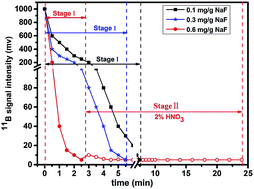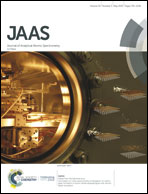Elimination of the boron memory effect for rapid and accurate boron isotope analysis by MC-ICP-MS using NaF†
Abstract
Boron isotopes are useful tracers for fluid–rock interactions and subduction processes, as well as a proxy for paleo-ocean pH. However, the strong B memory effect presents a great challenge in precisely measuring B isotope ratios and accurately using multi-collector inductively coupled plasma mass spectrometry. In this study, we present the first systematic study to examine the effectiveness of eliminating the B memory effect by using different rinse solutions. The results demonstrate that F-based rinse solutions (HF and NaF) are the most effective. However, using HF as a rinse solution will require a high content of HF (more than 0.3 M) or a low content of HF with the samples also in an HF medium, and requires special care because HF is highly toxic. By contrast, NaF (0.6 mg g−1 NaF in 1% HNO3 solution) is equally effective regardless of the sample acid matrix. In addition, high concentration Na solution does not affect the stability of plasma, or result in unexpected mass bias during the analytical courses. It only takes less than 4 min to reduce the B signal to blank levels using NaF rinse solution. The long-term analysis of B reference materials over a year yields great reproducibility using acidified NaF as a rinse solution, with NIST SRM 951a, ERM-AE121, and GSB07-1979-2005 (in-house standard) with δ11B = 0.01 ± 0.11, 20.29 ± 0.48 and −13.32 ± 0.40‰ (2SD, n = 27), respectively, which indicates that excellent precision can be achieved for boron isotope measurement. A series of natural samples with diverse matrices covering a large range of δ11B variations in the natural environment were measured using this protocol and yielded better results. Therefore, our protocol is applicable to a wide field of B isotope research that requires high precision and accuracy.



 Please wait while we load your content...
Please wait while we load your content...